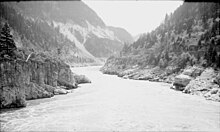Fraser Canyon
This article includes a list of generalreferences,butit lacks sufficient correspondinginline citations.(October 2015) |
Fraser Canyon | |
|---|---|
 View of Fraser Canyon near Fountain, British Columbia | |
Location inBritish Columbia,Canada | |
| Coordinates:49°38′00″N121°25′00″W/ 49.63333°N 121.41667°W | |
| Formed by | Fraser River |
TheFraser Canyonis a major landform of theFraser Riverwhere it descends rapidly through narrow rock gorges in theCoast Mountainsen route from theInterior PlateauofBritish Columbiato theFraser Valley.Colloquially, the term "Fraser Canyon" is often used to include the Thompson Canyon fromLyttontoAshcroft,since they form the same highway route which most people are familiar with, although it is actually reckoned to begin aboveWilliams LakeatSoda Creek Canyonnear the town of the same name.[citation needed]
Geology
[edit]
The canyon was formed during theMioceneperiod (23.7–5.3 million years ago) by the river cutting into the uplifting Interior Plateau. From the northernCaribootoFountain,the river follows the line of the huge Fraser Fault, which runs on a north–south axis and meets the Yalakom Fault a few miles downstream fromLillooet.Exposures of lava flows are present in cliffs along the Fraser Canyon. They represent volcanic activity in the southernChilcotin Groupduring thePlioceneperiod and the volcanic vents of their origins have not been discovered.
Geography
[edit]
The canyon extends 270 kilometres (170 mi) north ofYaleto the confluence of theChilcotin River.Its southern stretch is a major transportation corridor to theInteriorfromthe Coast,with theCanadian NationalandCanadian PacificRailways and theTrans-Canada Highwaycarved out of its rock faces, with many of the canyon's side-crevasses spanned by bridges and trestles. Prior to the double-tracking of those railways and major upgrades to Highway 1 (the Trans Canada Highway), travel through the canyon was even more precarious than it is now. During the frontier era it was a major obstacle between the Lower Mainland and the Interior Plateau, and the slender trails along its rocky walls – many of them little better than notches cut into granite, with a few handholds – were compared to goat-tracks.
North ofLytton,it is followed byBC Highway 12,then from Lillooet toPavilionbyBC Highway 99(the farther end of theSea-to-Sky Highway,though not carrying that name in this area). TheBritish Columbia Railway(now operated by the CN) line follows the same stretch of canyon from Lillooet to just beyond Pavilion]. Between there and the mouth of theChilcotin Riverthere are only rough ranching roads, and the terrain is a mix of canyon depths flanked by arid benchland and high plateau. Between Pavilion and Lillooet, the river's gorge is at its maximum depth, with the river throttled through a series of narrow gorges flanked by high cliffs, though still flanked above those cliffs by wide benchlands which stand on the foreshoulder of the mountain ranges flanking the gorge.
Hells Gate
[edit]

AtHells Gate,nearBoston Bar,the canyon walls rise about 1,000 metres (3,300 ft) above the rapids.Fish laddersalong the river's side permit migratingsalmonto bypass a rockslide that diverted the river during the blasting of theCanadian Northern Railwayline in 1913. The area around Hell's Gate carries the name Black Canyon, which may either be a reference to the colour of the rocks when it rains, or the name of a community built on the cliffsides here during theFraser Canyon Gold Rush.At the site that once housed railway workers, a tourist attraction built in 1971 takes visitors across Hell's Gate via anaerial tramway.

AtSiska,a few minutes south of Lytton, there are theCisco bridges—a pair of railway bridges at the throat of a rocky gorge. From south to north, the Canadian Pacific has been on the west side of the canyon, while the Canadian National has been on the east side. At Siska, the two railways switch sides: the CP—160-metre-long (520 ft) truss bridge—crosses to the east, the CN—on an 250-metre (810 ft) steel-arched bridge over the CP—is now on the west. The two railways now have an agreement to allow directional running through the canyon as far as Basque. All eastbound trains—CN, CP, and Via Rail's eastboundCanadian—run on the CP line. All westbound trains—CN, CP, Via Rail's westboundCanadian—use the CN tracks.
Upper Fraser Canyon
[edit]Just north of Lillooet, narrow rock ledges choke the river just at the confluence of the lower canyon of theBridge River,forming an obstacle to migrating fish that has made this spot the busiest aboriginal fishing site on the river, from ancient times to the present. Concentrations ofFirst Nationspeople here, from all tribes of the Interior, were believed to have been in excess of 10,000.
Sub-canyons
[edit]Many stretches of the Fraser are named in their own right, starting with the Little Canyon between Yale andSpuzzum,which is officially the lowest reach of the Fraser Canyon (although in regional termsHope,32 kilometres (20 mi) farther south, is considered a canyon town and to be the southern outlet of the canyon because the highway became more difficult from that point; the river is navigable to Yale). Between the Spuzzum and Boston Bar was known in thegold rushas the Big Canyon or Black Canyon;[1]there are several named subcanyons of the Big Canyon, most famouslyHells Gate Canyon(in some descriptions the Black Canyon is below Hell's Gate). Above the Big Canyon there are the Lillooet Canyon, Fountain Canyon, Glen Fraser Canyon, Moran Canyon, High Bar Canyon, French Bar Canyon and more all the way up to Soda Creek Canyon nearQuesnel.Upstream from there the river flows in wider country, but in theRobson ValleybetweenPrince GeorgeandTête Jaune Cache,the river enters theGrand Canyon of the Fraser.The Black Canyon was the site of a shantytown of the same name, much of which was on catwalks on the ramparts of its dark-rock cliffs.
Nearly all tributaries of the Fraser have canyons of varying scale; the few exceptions include the Pitt and the Chilliwack in the Lower Fraser Valley. TheThompson Canyon,from Lytton toAshcroft,is a sequence of large canyons of its own, some of them also named, although most British Columbians and travellers think of it as part of the Fraser Canyon. Other important canyons on tributaries includeCoquihalla Canyon,the Bridge River Canyon,Seton Canyonand adjacentCayoosh Canyon,Pavilion Canyon,Vermilion Canyon (Slok Creek) andChurn Creek Canyon.The Chilcotin River also has several subcanyons, as does theChilko River,notablyLava Canyonand another Black Canyon.
Upper canyons
[edit]There are other canyons on the Fraser that are not considered part of the canyon, notably atSoda Creek,betweenWilliams Lakeand Prince George. The official but comparatively diminutive Grand Canyon of the Fraser is in the river's upper stretch through theRocky Mountain Trench,about 115 km (71 mi) upstream from Prince George and about 20 km (12 mi) upstream from the Fraser's confluence with theBowron River.Despite its name, the Grand Canyon of the Fraser is only one treacherous switchback rapid in a shallow rock gorge, and it has neither the roughness of water nor the depth and severity of canyon as is found in the area south from Big Bar to Lillooet or between Boston Bar and Yale.
Almost all of the rivers and creeks feeding the Fraser from Williams Lake south have their own canyons which open onto the Fraser, or are just up side-valleys a few miles. These includeMarble Canyon,Churn Creek,the Chilcotin River, theBridge River,Seton LakeandCayoosh Creek,theStein River,theNahatlatch River,theCoquihalla Riverand the innumerable smaller creeks flanking the river betweenKanaka Barand Yale.
Tunnels
[edit]The Canadian Pacific Railway has at least 30 tunnels in its Yale to Lytton section with one up to half a mile in length. The Fraser Canyon Highway Tunnels were constructed from the spring of 1957 to 1964 as part of the Trans-Canada Highway project. There are seven tunnels in total, the shortest being approximately 57 metres (187 ft); the longest, however, is approximately 610 metres (2,000 ft) and is one ofNorth America's longest. They are situated between Yale andBoston Bar.
In order from south to north, they are: Yale (completed 1963), Saddle Rock (1958), Sailor Bar (1959), Alexandra (1964), Hell's Gate (1960), Ferrabee (1964) and China Bar (1961). The Hell's Gate tunnel is the only tunnel that does not have lights, while the China Bar tunnel is the only tunnel that requires ventilation.
The China Bar and Alexandra tunnels have warning lights that are activated by cyclists before they enter the tunnels. This was required because the tunnels are curved. It is expected that the Ferrabee tunnel will get the same warning lights as it too is curved.[citation needed]
History
[edit]At the mouth of the Canyon, an archeological site documents the presence of theStó:lōpeople in the area from the earlyHoloceneperiod, 8,000 to 10,000 years ago after the retreat of theFraser Glacier.Research farther upriver at theKeatley Creek Archaeological Site,near Pavilion, is dated to 8000 BP, when a huge lake filled what is now the canyon above Lillooet, created by a slide a few miles south of the present-day town.
During the Fraser Canyon Gold Rush of 1858–1860, 10,500 miners and an untold number of hangers-on populated its banks and towns. TheFraser Canyon Warand the series of events known asMcGowan's Waroccurred during the gold rush. Other important histories connected with the canyon include the building of theCariboo Wagon Roadand the construction of the Canadian Pacific Railway.
The river is navigable between Boston Bar and Lillooet and also between Big Bar Ferry and Prince George and beyond, although rapids at Soda Canyon and elsewhere were still difficult waters for the many steamboats which piloted the river in the 19th and early 20th centuries. The first sternwheeler to pass the rapids wasSkuzzy,which was built with a multiple-compartment hull to preserve her from sinking from rock damage. She was used to haul equipment and supplies during the construction of the Canadian Pacific Railway, beginning in the 1880s.
With the construction of the Canadian Pacific Railway in the 1880s came the destruction of key portions of theCariboo Wagon Road,as there was no room for both railway and road on the narrow, steep mountainsides above the river. As a result, the towns of Lytton and Boston Bar were cut off from road access with the rest of the province, other than by the difficult wagon road to Lillooet via Fountain. During the automotive age and following the construction of the Canadian Northern Railway in 1904–05, a newer version of the road was built through the canyon. The Fraser Canyon Highway was surveyed in 1920 and constructed in 1924–25 with a through-route available after the completion of the (second)Alexandra Suspension Bridgein 1926. This was known as the Cariboo Highway and Highway 1 until the construction and designation of the Trans-Canada Highway (circa-1962).[2][page needed]
See also
[edit]Water sources
[edit]Towns and localities
[edit]Other
[edit]References
[edit]- ^BCGNIS entry "Black Canyon"Archived2007-08-15 atarchive.today
- ^Harris, Lorraine (1984).Fraser Canyon, from Cariboo road to super highway.Surrey, B.C.: Hancock House.ISBN088839182X.
Further reading
[edit]- Prentiss, Anna Marie; Kuijt, Ian (2012).People of the middle Fraser Canyon an archaeological history.Vancouver: UBC Press.ISBN9780774821704.
- Waite, Donald E. (1988).The Fraser Canyon story.Surrey, B.C.: Hancock House.ISBN9780888392046.
- York, Annie (2011).Spuzzum: Fraser Canyon Histories 1808-1939.UBC Press.ISBN9780774841887.

